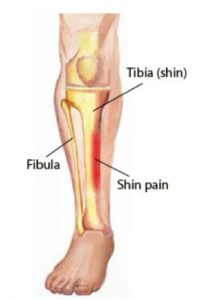The term “shin splints”, medically known as medial tibial stress syndrome (MTSS), refers to a painful inflammation along the shinbone (tibia) — the large bone in the front of your lower leg. The pain generally occurs along the inside or outside of the tibia bone, and is a common sports injury, seen in runners, dancers and military recruits who have recently intensified or changed their training routines.

Cause
Shin splints are caused by repetitive stress applied to the connective tissues that attach your muscles to the shinbone, and by over- pronation of your feet.
They are more common in those who have been sedentary for some time, and suddenly take up vigorous exercise. The muscles, tendons and bone tissue become overworked by the increased activity, leading to the inflammation.
Symptoms
If you have shin splints, you may notice:
- Tenderness or pain along the inner part of your lower leg
- Mild swelling in your lower leg aggravated by activity
Treatment
After an assessment by your Chiropodist or Podiatrist (Foot Specialists), treatment for your shin splint may include physiotherapy, a muscle stretching/strengthening program, footwear advice and Custom Foot Orthotics.
In most cases, you can treat shin splints simply with:
- Rest: Avoid activities that cause the swelling or discomfort, but don’t give up all physical activity. While you’re healing, try low-impact exercises, such as swimming, bicycling or water running.
- Ice: Apply ice packs to the affected shin for 15 to 20 minutes at a time, 4 to 6 times a day for several days.
- Anti-inflammatory medication (NSAID): Try ibuprofen (Advil), naproxen (Aleve) or acetaminophen (Tylenol) to reduce pain and swelling. Use as indicated on the bottle.
Prevention
- Choose the right shoes: Wear footwear that suits your activity. If you’re a runner, replace your shoes about
every 560 to 800 kilometers. - Use Custom Foot Orthotics: Orthotics can help prevent shin splints by correcting for over-pronation, especially if you have flat fleet.
- Stretch and Strengthen: Ensure to properly stretch all muscle groups before partaking in physical activity, and strengthen your posterior leg muscles.
Contact us today to see how we can help alleviate pain associated with shin splints.

